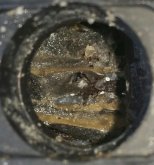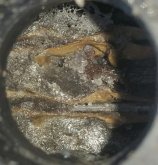WoodsieLord
New Member
Short version: One out of four batteries in series drops to 10.5V after a few amps.
----
A little background for context:
I have a bank of 4 alphacell 86A deep cycle GEL batteries that I got as new (unused) a year ago. Since I'm not living offgrid I've been using them pretty much as a super big UPS battery bank. I don't usually cycle them since I switch to solar when the sun is out and the bank is at 100% and switch back to grid before the sun sets. They're set in series to reach 48V.
I've run 5 "long" tests where I took them to 75% DoD (most of those times) and down to 59% once. Never went beyond that. Also, I did those tests at a constant 170W load (around 3,5 ~ 4A)
Two weeks ago, I replaced my PWM SCC for an Epever MPPT SCC. I read the manual before buying it so I knew beforehand that I had to configure it to use GEL charging profile (no equalization). The very next days were clowdy so I had to wait a few days until forecast was good for a proper test.
The night before the good forecasted day I started a drain test expecting to get near 55% ~ 65% DoD.
Three hours into the test and the UPS shut off. The bank had reached 42V (under load) right before the shut off.

(I collect this info through a voltage dividier then an Arduino then a raspberry pi then a home server. All DIY, so take into consideration that this might be inaccurate. Perhaps by 1 volt. It let's me see the "big picture".)
At first I did not suspect a battery was faulty so I spent some time upgrading the wires. I ran a second test with the same outcome.
I usually run these tests at night where my loads are small and very constant (load consists of a computer, wifi, security camera and some led bulbs occasionally used when going to the toilet! no motors, no surge spikes)
Yesterday, I ran a test under a slightly greater load (fairly big Lcd tv, more lights, audio amplifyier). This time, I was meassuring the batteries individually with a voltmeter every few minutes. One hour twenty minutes into the test and this single battery dropped voltage to 10.6V. (The other three were above 12.15V) I had seen enough so I aborted the test right there.
My batteries have no local warranty, and shipping lead acid batteries to USA/Mexico is out of the question. So today I stripped the label and took the vent plugs off to take some pictures.
All six cells look almost the same, I have never been this intimate with a proper GEL battery.... I don't know if there is something wrong or if there is nothing to see to the naked eye.
I saw a bunch of lousy GEL battery restoration videos. Basically they all add distilled water in. One of them extracted acid-water mix from a flooded 'donor'. I'm willing to experiment but I would rather ASK for advice first. So here I am. And here are the pictures I took:




Thanks in advance!
----
A little background for context:
I have a bank of 4 alphacell 86A deep cycle GEL batteries that I got as new (unused) a year ago. Since I'm not living offgrid I've been using them pretty much as a super big UPS battery bank. I don't usually cycle them since I switch to solar when the sun is out and the bank is at 100% and switch back to grid before the sun sets. They're set in series to reach 48V.
I've run 5 "long" tests where I took them to 75% DoD (most of those times) and down to 59% once. Never went beyond that. Also, I did those tests at a constant 170W load (around 3,5 ~ 4A)
Two weeks ago, I replaced my PWM SCC for an Epever MPPT SCC. I read the manual before buying it so I knew beforehand that I had to configure it to use GEL charging profile (no equalization). The very next days were clowdy so I had to wait a few days until forecast was good for a proper test.
The night before the good forecasted day I started a drain test expecting to get near 55% ~ 65% DoD.
Three hours into the test and the UPS shut off. The bank had reached 42V (under load) right before the shut off.

(I collect this info through a voltage dividier then an Arduino then a raspberry pi then a home server. All DIY, so take into consideration that this might be inaccurate. Perhaps by 1 volt. It let's me see the "big picture".)
At first I did not suspect a battery was faulty so I spent some time upgrading the wires. I ran a second test with the same outcome.
I usually run these tests at night where my loads are small and very constant (load consists of a computer, wifi, security camera and some led bulbs occasionally used when going to the toilet! no motors, no surge spikes)
Yesterday, I ran a test under a slightly greater load (fairly big Lcd tv, more lights, audio amplifyier). This time, I was meassuring the batteries individually with a voltmeter every few minutes. One hour twenty minutes into the test and this single battery dropped voltage to 10.6V. (The other three were above 12.15V) I had seen enough so I aborted the test right there.
My batteries have no local warranty, and shipping lead acid batteries to USA/Mexico is out of the question. So today I stripped the label and took the vent plugs off to take some pictures.
All six cells look almost the same, I have never been this intimate with a proper GEL battery.... I don't know if there is something wrong or if there is nothing to see to the naked eye.
I saw a bunch of lousy GEL battery restoration videos. Basically they all add distilled water in. One of them extracted acid-water mix from a flooded 'donor'. I'm willing to experiment but I would rather ASK for advice first. So here I am. And here are the pictures I took:




Thanks in advance!




